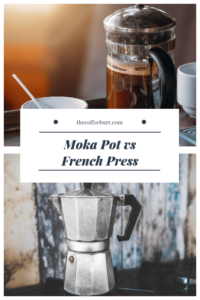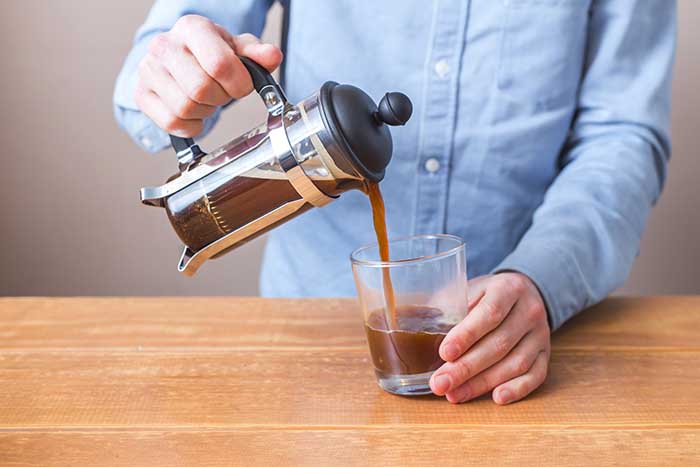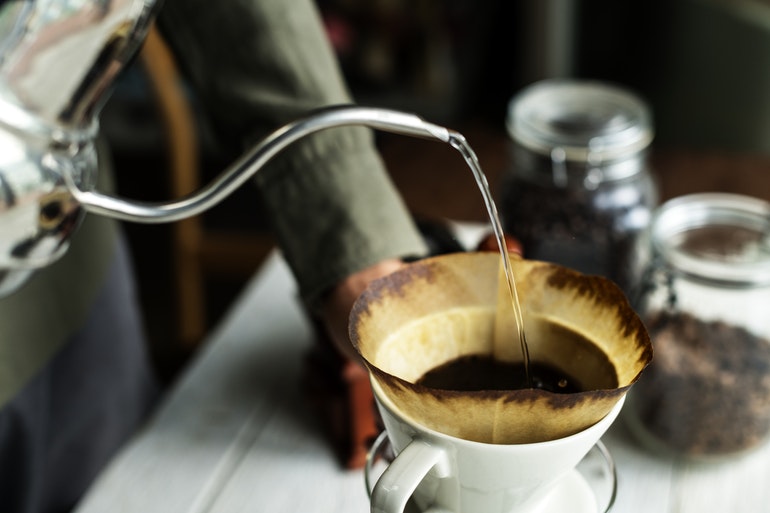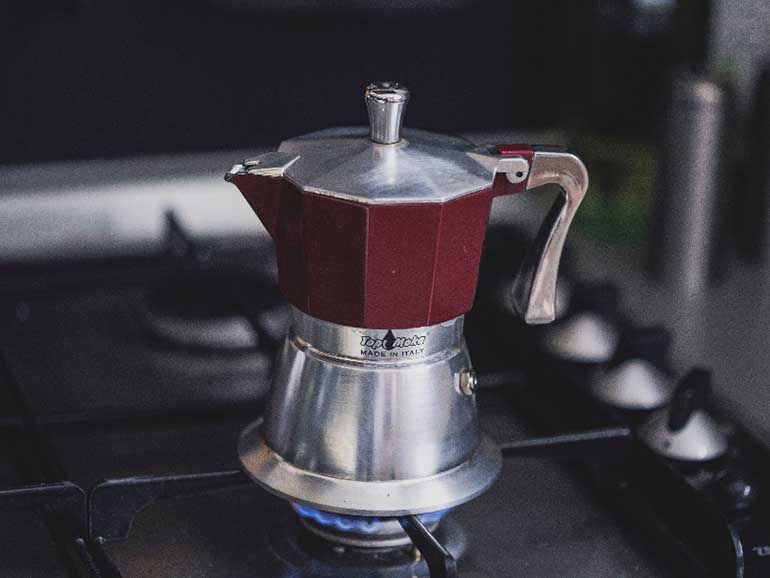Everyone has their own preferred type of coffee, and I bet you’re no different.
The invigorating cup that most of us need to wake up in the morning has many different preparation methods. Most die-hard coffee fanatics swear by their preferred way of making coffee and give no room for debate on any other method.
That’s ok though. As coffee lovers we know what we love, and we’re going to stick with it.
There are however two brewing methods in particular that are considered the classics, and these boil down to (pun definitely intended) the Moka pot and the French press.
These two have distinctive styles of making coffee. While the Moka pot generally makes a strong brew, the French press or the cafetiere provides a richer and more full-bodied taste profile.
From the make to the resulting coffee, there are a lot of differences between the two.
What exactly are these distinctions though? In today’s guide I’m going to walk you through the 7 main differences between Moka and French press, and when you should be using which one.
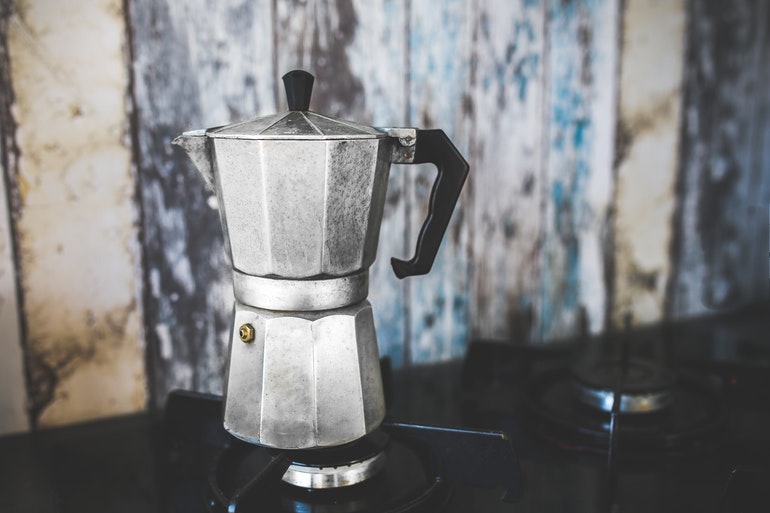
But first, a quick intro to both the Moka and the French press:
The Moka pot
The Moka pot is an aluminum or steel stove-top appliance (although electric versions have started to appear out there) that uses steam to brew its grounds.
It was first designed in 1933 by an Italian engineer called Alfonso Bialetti, it’s come a long way and still continues to be popular today. In fact, Bialetti Industrie still makes Moka pots with the same original design today.
OK, quick history lesson over. How does it work?
It uses finely ground coffee beans to make a perfect cup of strong coffee, and comes in different sizes for different servings.
The basic contraption is pretty simple: Two separate compartments, the boiler and the filter, are used to prepare coffee. Water is boiled in the boiler to generate steam, which is then passed through the coffee to extract the flavors and aromas.
Moka pot brewed coffee might produce a little foam but it has much more caffeine content than your typical espresso. The Moka pots are sometimes referred to as stove-top espresso makers although the brew cannot be explicitly described as espresso.
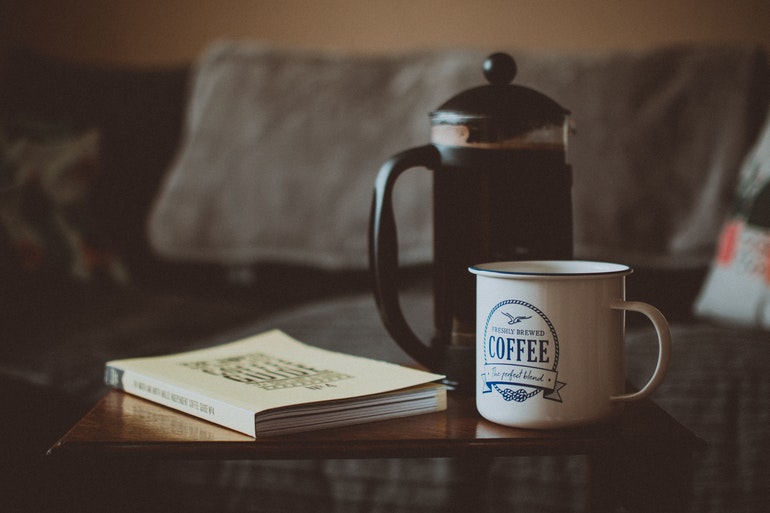
The French press
Two main parts make up the French press brewer: A transparent beaker, and a lid and a plunger fitted perfectly into it. This plunger is fitted with a stainless steel wire or nylon mesh filter in order to separate the grounds from the main body of your drink.
Final quick history lesson: The French press was also invented in Italy (not France!), and was patented in 1929.
The brewing method requires freshly ground coffee but of a coarser nature. If the coffee is ground too finely, it could lead to the coffee turning bitter. This is because finely ground coffee is not only likely to seep through the filter and into the coffee, but also because it can lead to over-extraction.
French press is also very easy to make. A fresh brew is prepared by putting ground coffee into the beaker and then pouring hot water in it. The coffee is allowed to brew for two to four minutes, but anything longer will put the coffee at risk of turning bitter. The plunger is then pressed to push the heavy grounds to the bottom.
Apart from the taste and the texture, there are several key differences between the two methods of brewing coffee. Here are seven of the biggest that you’ll find between them.
#1. The coffee grounds
One of the biggest contracts between the two methods is the grind size that each needs.
The coffee for a Moka pot needs to be finely ground so that the steam passing through it can do so at high pressure and force the extraction of the coffee flavors and aromas.
Not the case with French press though:
Instead, French press needs grounds that are far more coarse. Why is this? Well, French press brewing involves leaving the grounds to steep, so anything too fine will over-extract and give you a really nasty tasting brew.
Instead, coarse grounds help accommodate a much more full-bodied and subtle flavor, making them perfect for French press.
#2. Brewer material
Both devices have different dimensions and are made of different materials. While the Moka is made of metal, either stainless steel or aluminum, the French press is generally made of plastic or glass. The plunger might be made of metal but the beaker is generally made of transparent material.
A modern day problem with Moka pots is that while they work perfectly on old fashion stove tops, they’re not compatible with modern induction cookers. This is because the aluminum or steel on the base of the pot simply can’t be heated by them.
If you have an induction cooker, then don’t fret: An electric Moka pot will help you make a fairly authentic version without the need of a stove top.
#3. Extraction
As you’ve probably guessed from the amount of time I’ve dropped the word in this post, extraction really is key.
If you over-extract, your coffee is too bitter. If you under-extract then your coffee is bland.
Different brewers use different methods to compliment the type of coffee being used. With Moka it’s all about forcing solubles out of the coffee at high pressure, and with French press it’s about allowing the coffee to steep and extract much more slowly.
So how exactly do they do this?
The Moka pot utilizes steam emanating from boiling water in its base to extract the flavor and smell from the coffee grounds. This can take a little bit of time while you wait for the water to boil, but once it gets going the process of the steam extracting the coffee is fairly quick.
With French press, the coffee flavor is extracted by pouring hot water on the coffee grounds and pressing them using an airtight plunger.
#4. Flavors
Although Moka isn’t espresso in the strictest sense, it is the closest you can come to an espresso at home without splurging out on an espresso machine.
That said, most Moka pots are unable to create the iconic espresso crema at the top of the drink. This is because the pressure level of a Moka brewer comes nowhere close to the 6-bar mark of pressure needed to create it.
However, there are some Moka pots with Cremator valves that can create more pressure in order to produce crema.
Either way, some people prefer it for its more concentrated coffee taste. It also packs in a bit of a kick, so if you’re a bit of a caffeine fiend (or ‘caffiend’) then this is for you.
In contrast, the flavor profile of French press is much more nuanced. Because the grounds are left to steep for several minutes, the water brings out a lot of the flavors in the beans. It creates a richer, full-bodied taste that not a lot of other types of drink capture.
#5. Time Required
Your choice of coffee maker might simply come down to what you have time for in the mornings. For most of us, coffee is a breakfast staple. It gives us the energy to get going. But if you’re strapped for time then choice of brewing methods might not be a luxury that you can afford.
If you’re able to spend time on breakfast in the mornings and like to give your coffee some time to simmer, I recommend going for for the French press. It requires a fresh batch of ground coffee and the temperature of the water should be just below boiling point. In short, it requires a bit more care and attention.
On the other hand, if your mornings are more chaotic and leave you in a bit of a squeeze then reach for the Moka pot. You can use pre-ground coffee (yes, really) and all you have to do is wait for the water to boil and voila: Your coffee is ready.
#6. Grinding
The Moka pot is much more convenient when it comes to ground beans.
While I would always say that you should buy wholebean coffee and grind it yourself, this isn’t as important with Moka brewing. It doesn’t allow for the more subtle and delicate notes of the coffee to come through as French press, so the difference between pre-ground and home-ground is nowhere near as pronounced.
With French press, however, I would urge you to grind at home.
Sure, you can buy pre-ground medium roasts that are designed to be used in French press brewers, but you will be rewarded for buying whole bean far more.
#7. Brewing experience
While you do have a bit more freedom to experiment with Moka, this flexibility also presents more opportunities for your brew to go wrong.
This can come in the form of getting your grind size wrong, messing up the tamping, or using overly-cold water
It can take several attempts before you start to understand what you’re doing right, or even what you’re doing wrong. There’s a fair bit of a trial and error, and this means it’s not for everyone.
French press on the other hand is much more beginner-friendly. It’s a simple case of adding water to grounds, leaving it to steep, and plunge.
Despite these differences, there’s also a lot that they share in common. Both are Italian in origin and fairly cheap to buy. In fact, because the coffees they produce are so remarkably contrasting, it’s not uncommon for kitchens to have both tools.
Which brewing method do you prefer? Let me know in the comments below!
